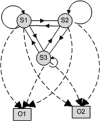Natural language processing: an introduction
- PMID: 21846786
- PMCID: PMC3168328
- DOI: 10.1136/amiajnl-2011-000464
Natural language processing: an introduction
Abstract
Objectives: To provide an overview and tutorial of natural language processing (NLP) and modern NLP-system design.
Target audience: This tutorial targets the medical informatics generalist who has limited acquaintance with the principles behind NLP and/or limited knowledge of the current state of the art.
Scope: We describe the historical evolution of NLP, and summarize common NLP sub-problems in this extensive field. We then provide a synopsis of selected highlights of medical NLP efforts. After providing a brief description of common machine-learning approaches that are being used for diverse NLP sub-problems, we discuss how modern NLP architectures are designed, with a summary of the Apache Foundation's Unstructured Information Management Architecture. We finally consider possible future directions for NLP, and reflect on the possible impact of IBM Watson on the medical field.
Conflict of interest statement
Figures




Similar articles
-
Using clinical Natural Language Processing for health outcomes research: Overview and actionable suggestions for future advances.J Biomed Inform. 2018 Dec;88:11-19. doi: 10.1016/j.jbi.2018.10.005. Epub 2018 Oct 24. J Biomed Inform. 2018. PMID: 30368002 Free PMC article.
-
Large language models for biomedicine: foundations, opportunities, challenges, and best practices.J Am Med Inform Assoc. 2024 Sep 1;31(9):2114-2124. doi: 10.1093/jamia/ocae074. J Am Med Inform Assoc. 2024. PMID: 38657567
-
A comparison of word embeddings for the biomedical natural language processing.J Biomed Inform. 2018 Nov;87:12-20. doi: 10.1016/j.jbi.2018.09.008. Epub 2018 Sep 12. J Biomed Inform. 2018. PMID: 30217670 Free PMC article.
-
Medical Information Extraction in the Age of Deep Learning.Yearb Med Inform. 2020 Aug;29(1):208-220. doi: 10.1055/s-0040-1702001. Epub 2020 Aug 21. Yearb Med Inform. 2020. PMID: 32823318 Free PMC article. Review.
-
A scoping review of publicly available language tasks in clinical natural language processing.J Am Med Inform Assoc. 2022 Sep 12;29(10):1797-1806. doi: 10.1093/jamia/ocac127. J Am Med Inform Assoc. 2022. PMID: 35923088 Free PMC article. Review.
Cited by
-
Trends in Glucagon-Like Peptide-1 Receptor Agonist Social Media Posts Using Artificial Intelligence.JACC Adv. 2024 Aug 28;3(9):101182. doi: 10.1016/j.jacadv.2024.101182. eCollection 2024 Sep. JACC Adv. 2024. PMID: 39372460 Free PMC article.
-
Development and Portability of a Text Mining Algorithm for Capturing Disease Progression in Electronic Health Records of Patients With Stage IV Non-Small Cell Lung Cancer.JCO Clin Cancer Inform. 2024 Oct;8:e2400053. doi: 10.1200/CCI.24.00053. Epub 2024 Oct 4. JCO Clin Cancer Inform. 2024. PMID: 39365963 Free PMC article.
-
Sentiment analysis in medication adherence: using ruled-based and artificial intelligence-driven algorithms to understand patient medication experiences.Int J Clin Pharm. 2024 Oct 4. doi: 10.1007/s11096-024-01803-0. Online ahead of print. Int J Clin Pharm. 2024. PMID: 39365522
-
Significance of Artificial Intelligence in the Study of Virus-Host Cell Interactions.Biomolecules. 2024 Jul 26;14(8):911. doi: 10.3390/biom14080911. Biomolecules. 2024. PMID: 39199298 Free PMC article. Review.
-
Use of Natural Language Processing to Extract and Classify Papillary Thyroid Cancer Features From Surgical Pathology Reports.Endocr Pract. 2024 Nov;30(11):1051-1058. doi: 10.1016/j.eprac.2024.08.008. Epub 2024 Aug 26. Endocr Pract. 2024. PMID: 39197747
References
-
- Manning C, Raghavan P, Schuetze H. Introduction to Information Retrieval. Cambridge, UK: Cambridge University Press, 2008
-
- Hutchins W. The First Public Demonstration of Machine Translation: the Georgetown-IBM System, 7th January 1954. 2005. http://www.hutchinsweb.me.uk/GU-IBM-2005.pdf (accessed 4 Jun 2011).
-
- Chomsky N. Three models for the description of language. IRE Trans Inf Theory 1956;2:113–24
-
- Aho AV, Sethi R, Ullman JD. Compilers: Principles, Techniques, Tools. Reading, MA: Addison-Wesley, 1988
-
- Chomsky N. On certain formal properties of grammars. Inform Contr 1959;2:137–67
Publication types
MeSH terms
Grants and funding
LinkOut - more resources
Full Text Sources
Other Literature Sources


